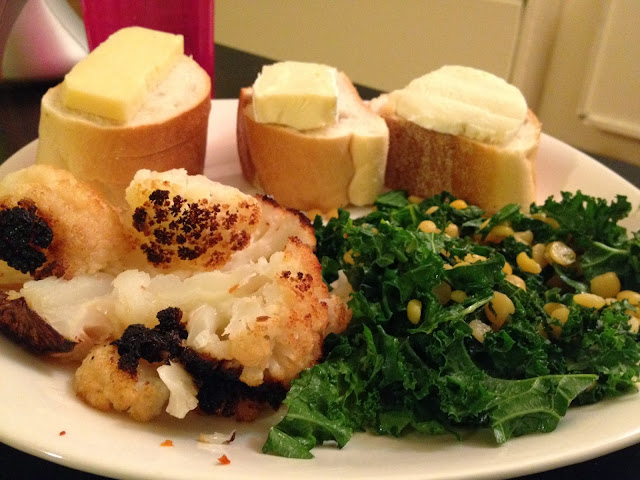Throughout my teenage years I had a tendency to read teen magazines that encouraged girls to take their look "from drab to fab!" Of course, my love for denim shorts and my oversized Rancho Bernardo High School hoodie proved more powerful than the influence of Seventeen's rhyming headlines, and my "look" remained about the same until I moved to New York (though if the high school where I now work made a hoodie, I know I would sport it day in and day out).
I'm not a huge fan of trying to get people to change their personal style to meet an arbitrary societal expectation, but in the world of foods there are definitely some ingredients that tend to be "drab" without a little accessorizing. Cauliflower ranks among the most notorious yawn-worthy foods, in my opinion. Sauteed, it never gets quite tender enough. Steamed, it just tastes watery. Even the color is boring. But there is hope for the poor, boring stepsister to broccoli.

After my love for cauliflower was kindled, Food 52 seduced me further into the world of cauli-cooking by running a recipe for a tender, toasty, and flavorful Whole Roasted Head of Cauliflower. It had always seemed like something that could only be done in restaurants, but after memorizing and trying the recipe I now know the secret. A 15 minute poach provides the flavor and tenderizes the inside, while a nice hot 40 minute roast guarantees the crackly exterior and charred taste without fear of burning. The overall preparation time is long, but the hands-on part is minimal. Plus, it leaves so much leftover broth that I am already planning round two.
Whole Roasted Cauliflower
Memorized and modified from Food 52
Yield: 4 side servings or 2 entree servings
Ingredients:
- 8 1/2 cups water
- 2 1/2 cups white wine (I used Pinot Grigio)
- 1/3 cup olive oil
- 2 heaping tbsp salt
- 1 tbsp sugar
- 2 tbsp lemon juice
- 1 heaping tbsp red pepper flakes
- 2 tbsp butter
- 1 head cauliflower, leaves and stems trimmed
Preparation:
- Preheat the oven to 475°F.
- Combine the first eight ingredients in a large pot and bring to a boil.
- Carefully place the head of cauliflower into the liquid. Reduce the heat to a low flame and simmer for 15-20 minutes, spooning the liquid onto the exposed cauliflower every once in a while. Halfway through the simmer time, carefully turn the cauliflower over (I used a spoon and tongs).
- Turn off the heat and lift the cauliflower out of the pot. Place in a colander to drain for a couple of minutes.
- Transfer the cauliflower to a baking dish and put in the oven (middle rack) for 40-50 minutes. Rotate the pan halfway through.
- Remove from the oven, slice into wedges, and enjoy!
 |
| Each step is simple yet valuable in the creation of this beautiful vegetable dish. |
The results of this recipe were fabulous. Not only did the cauliflower take on the multiple flavors of the poaching broth, but it also caramelized those flavors around the edges during the roasting process. The single head of cauliflower made four servings, technically, but I wouldn't put it past myself to eat the whole thing. It had the slightest hint of spice, lots of flavor from the wine, and the perfect amount of fat to round out the texture. I served my cauliflower with a kale and split-pea salad and some bread and cheese. Delicious, simple goodness.
The key components of the broth were basic enough that I bet they would transfer to other flavor profiles as well:
- Water
- Alcohol for flavor: wine/ sake/ mirin
- Something salty: salt/ soy sauce/ mustard
- Fat: olive oil/ vegetable oil mixed with a little sesame oil/ butter only
- Acid: lemon juice/ lime juice/ orange juice/ grapefruit juice/ vinegar
- Sweet: sugar/honey/maple syrup
- Spicy: red pepper flakes/ cayenne/ sriracha
The options are endless, and the flavors end up complex. Play around with it and leave a comment if you try a version of this easy and unique recipe.

No comments:
Post a Comment